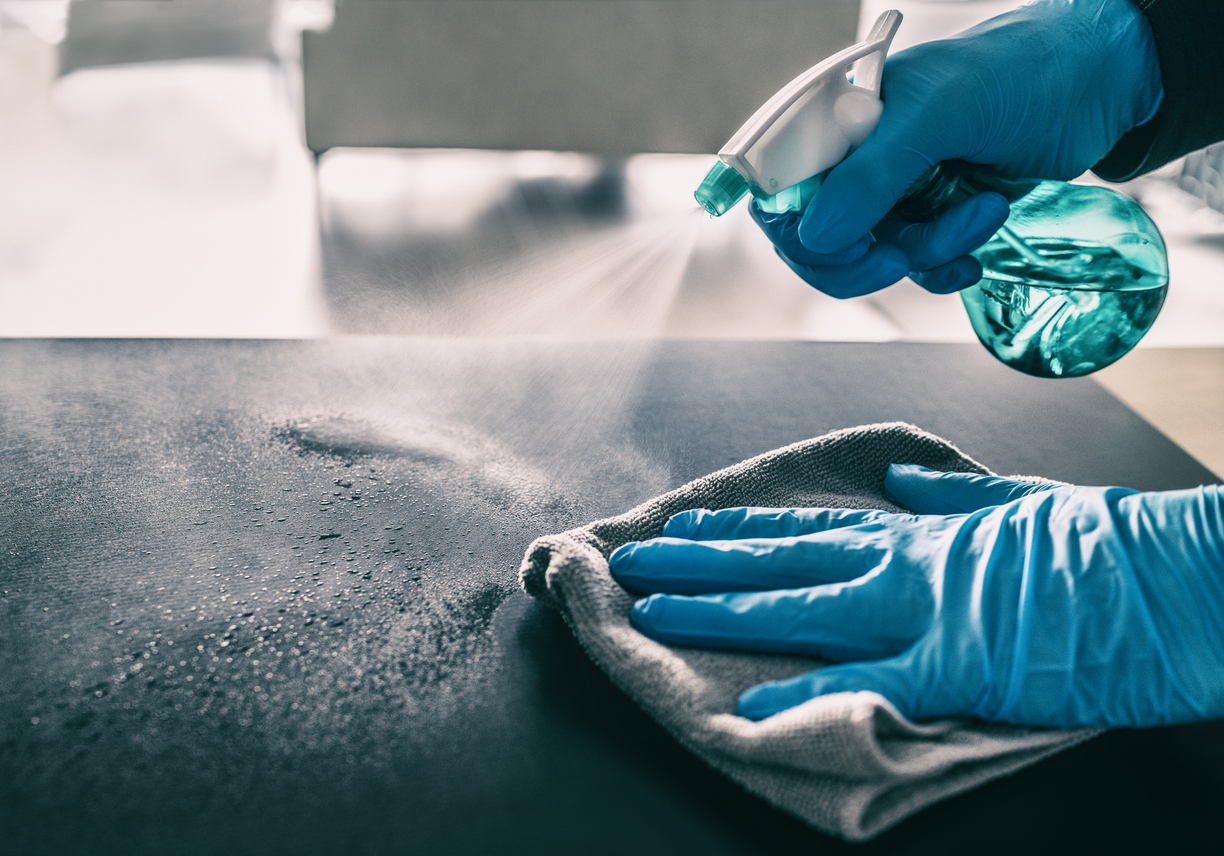
Microbicides: Music to the Ears
Written by Diane M. Calabrese | Published May 2024

Microbicidal is a word that’s become music to the ears of many, many people during the last few years. Compounds that can eliminate microbes—viruses, bacteria, fungi—from surfaces allow us to create more hygienic and sanitary environments. Bleach plays a microbicidal role. It also plays a cosmetic role.
For all its ubiquity in the world of cleaning, bleach is a relatively new entry to the tools we use to thwart entities that contaminate the environment. The history of bleach begins with the identification of chlorine in 1774.
Today, when we speak of bleaching agents in our industry, a dilute solution of sodium hypochlorite (NaOCl) is most generally what we mean. Sodium hypochlorite is used across many sectors to disinfect, and as a corollary to tamp down odors as well as to whiten.
[Note: There are many bleaching agents/compounds in the chemical sphere. The shorthand “bleach” in the general lexicon almost always refers to a dilute solution of sodium hypochlorite, which corresponds to the meaning attached to it here.]
So useful is bleach that the phrase “bleach additive” might seem curious. But every solid entry in the industrial sphere has a purpose.
To sort things out for us, we turned to an expert on bleach and bleach additives, Joseph Daniel, CEO of ITD Chemical in Tucker, GA.
Let’s start with bleach additives. How are they defined? The additives are chemical products that “enhance the cleaning properties of the bleach,” says Daniel. And there are several types of enhancements, including fragrance, foam generation, detergency and/or solvency, and marking dye.
Daniel explains the basics of each named enhancement: Fragrance masks the odor of bleach. Foam encourages a longer dwell time. Detergents and/or solvents create a robust cleaner that in turn reduces the amount of bleach required for an optimal cleaning outcome. Marking dye helps the soft-wash operator identify where solution has been applied.
“High-quality bleach additives can dramatically increase the effectiveness and efficiency of the cleaning process,” says Daniel. “Bleach by itself is a highly alkaline oxidizer and disinfectant, but it is not a well-rounded detergent.”
Members of our industry who include soft washing in their roster of services are familiar with the power of additives. “Bleach additives are critical for proper and efficient soft washing technique,” explains Daniel.
In fact, there are products that consist of bleach and an additive that contractors use regularly, although they may not realize they are using that combination. “Most products labeled as mold and mildew cleaners are essentially chlorinated detergents, which is bleach plus a detergent additive,” says Daniel.
There are two reasons mold and mildew cleaners are not used to clean an entire structure, explains Daniel.
They are too expensive, and the bleach concentration is typically too low.
In the context of cost effectiveness, Daniel offers a recommendation. “Bleach can and should be bought in bulk locally, and bleach additives added on site.”
Although foam generation and odor masking are perhaps the most common reasons for an additive, there are other ways to gain from use of additives. “The best products bring another level of cleaning efficiency,” explains Daniel.
That efficiency derives from “rinseability” and “bleach extension—in other words, use less bleach,” says Daniel. In fact, his company offers a product, Green Machine, that delivers that combination of results.
Bleach is a well-known entity across industries and even in homes. But that does not signal an invitation to complacency.
“Bleach is a highly corrosive and reactive chemical product,” says Daniel. “Care should be taken to review the Safety Data Sheet (SDS) for bleach, also known as sodium hypochlorite, in order to understand proper methods of handling. Proper PPE [personal protective equipment], at a minimum to include eye protection and gloves, should always be worn.”
In the context of safety, it’s imperative that additives and bleach are a match. “Adding an incompatible chemical product to bleach can be highly dangerous and even deadly,” explains Daniel.
And there’s another caution, too, says Daniel. “Contractors using bleach in the field should always stock a bleach neutralizer, such as [our company’s] Neutra Bleach.”
The neutralizer “protects plants, flushes equipment (to prevent corrosion), prevents bleach streak on windows, and neutralizes hazardous bleach,” explains Daniel. Use of a neutralizer is a “critical and inexpensive step”—one that cuts down on “headaches, expenses, and danger.”
A contractor must be committed to getting it right. “Operators should never use products that aren’t specifically designed to be added to bleach, and the product container should state that the product is bleach stable,” says Daniel.
“Acids—water-based chemicals with a pH under 7—should never be added to bleach,” explains Daniel. “This can create a reaction that results in chlorine gas, which is deadly. All bleach additives must be neutral or elevated pH.”
One of the many defining properties that put a compound in the acid category is that it reacts with a base to form a salt. Another is that it dissolves in water-forming hydrogen ions. Acid and sodium hypochlorite must never meet because chlorine gas will be released from the reaction. (Reminder: Chlorine gas was used in World War I.)
Chemicals incompatible with bleach include alcohols, ammonia-containing compounds, and more. “Bleach Incompatibilities,” from Stanford Environmental Health & Safety, is an excellent summary of cautionary notes. Geared to research safety, it’s a handy reference for anyone working with bleach (and other chemicals). See https://ehs.stanford.edu/ wp-content/uploads/Bleach-andincompatible-FactSheet-LSP-20-116.pdf
Bleach need not always be in the picture when abatement of certain microbes is the goal. “The other common mold, mildew, and management product category is quat [quaternary ammonium compounds] cleaners and/ or disinfectants,” says Daniel.
And Daniel’s company offers products such as Bio Bomber and Sani Quat 23. “They can serve a critical role in abatement efforts,” he explains. “However, they are slower acting than bleach-based products and can be more expensive for large projects.”
Owners choose alternatives such as quats when they want to avoid bleach or when surfaces of the structures are sensitive to bleach. “The advantage of these products is they provide a long-lasting barrier to future mold growth on the surface, which reduces the frequency of cleaning required in the future,” says Daniel.
But back to bleach and additives… “When bleach is being used, a bleach additive should always accompany it for best results,” explains Daniel. “There is no exterior soft-wash case where bleach would be better without an enhancing additive.”
The key for contractors is planning. Quat-based products provide “a long-lasting barrier on the surface, retarding future mold growth,” says Daniel. As such, they should be part of “a proper long-term mold management strategy.”
Bleach is fast-acting, says Daniel. But alone it is not a long-term mold management strategy.
To develop the best management plan, contractors should take advantage of the expertise of industry members who manufacture and distribute chemicals. And keep safety in mind.
In fact, says Daniel, it is possible to develop a plan based on periodic application of a quat-based product that eliminates the need to use bleach at all





